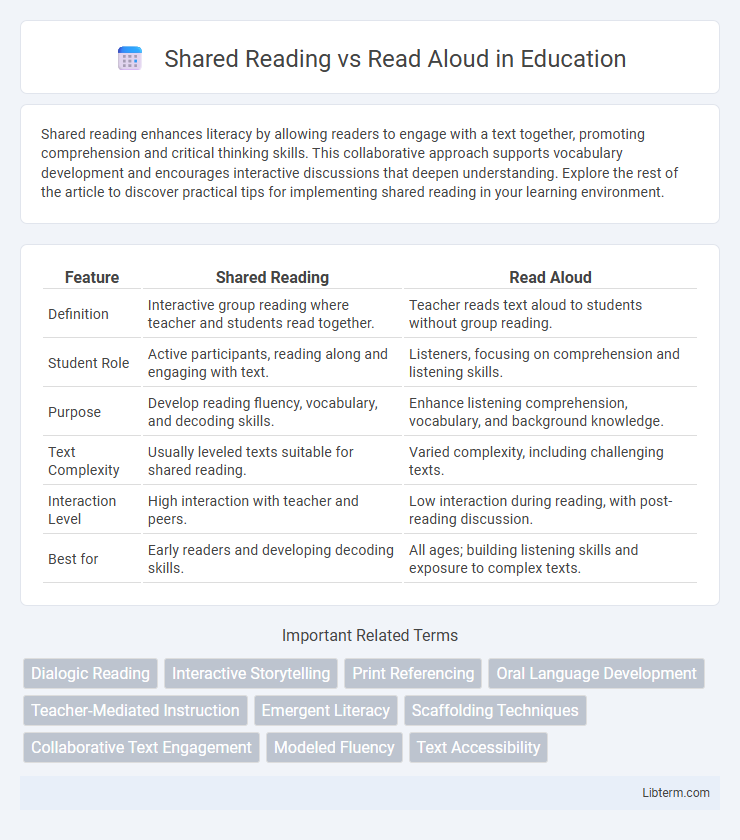Shared reading enhances literacy by allowing readers to engage with a text together, promoting comprehension and critical thinking skills. This collaborative approach supports vocabulary development and encourages interactive discussions that deepen understanding. Explore the rest of the article to discover practical tips for implementing shared reading in your learning environment.
Table of Comparison
| Feature | Shared Reading | Read Aloud |
|---|---|---|
| Definition | Interactive group reading where teacher and students read together. | Teacher reads text aloud to students without group reading. |
| Student Role | Active participants, reading along and engaging with text. | Listeners, focusing on comprehension and listening skills. |
| Purpose | Develop reading fluency, vocabulary, and decoding skills. | Enhance listening comprehension, vocabulary, and background knowledge. |
| Text Complexity | Usually leveled texts suitable for shared reading. | Varied complexity, including challenging texts. |
| Interaction Level | High interaction with teacher and peers. | Low interaction during reading, with post-reading discussion. |
| Best for | Early readers and developing decoding skills. | All ages; building listening skills and exposure to complex texts. |
Introduction to Shared Reading and Read Aloud
Shared reading involves interactive group engagement where the teacher guides students through a text, promoting active participation and comprehension skills. Read aloud is a teacher-centered approach where the educator reads a text aloud to the class, emphasizing fluency, intonation, and modeling expressive reading. Both strategies enhance literacy development but differ in the level of student involvement and instructional focus.
Defining Shared Reading
Shared Reading involves a collaborative approach where the teacher and students engage with a text simultaneously, often using a large, visible book or digital display to promote participation and interaction. It emphasizes active student involvement, prompting discussions, predictions, and responses to foster comprehension and fluency. Unlike a Read Aloud, which is primarily teacher-driven narration, Shared Reading creates an interactive learning experience that supports literacy development through shared dialogue and scaffolded reading strategies.
Understanding Read Aloud
Read Aloud is a dynamic instructional strategy where the teacher models fluent reading and expressive storytelling to enhance students' comprehension and listening skills. This approach exposes learners to rich vocabulary, complex sentence structures, and diverse literary genres, fostering engagement and critical thinking. Unlike Shared Reading, Read Aloud primarily centers on teacher-led narration, allowing students to develop deeper understanding through auditory input and interactive discussions.
Key Differences Between Shared Reading and Read Aloud
Shared reading involves interactive engagement where the teacher and students read a text together, promoting active participation and comprehension, while read aloud is primarily a teacher-centered activity focused on modeling fluent reading and exposing students to rich vocabulary. In shared reading, the text is usually visible to all students, facilitating simultaneous reading and discussions, whereas read aloud typically involves the teacher reading an unseen text to the students. Shared reading supports literacy skills like decoding and sight word recognition through repetitive reading, contrasting with read aloud's emphasis on listening skills and language development.
Benefits of Shared Reading
Shared reading promotes interactive engagement by involving children in the reading process, enhancing vocabulary development and comprehension skills. It fosters a collaborative learning environment where children actively participate, improving their confidence and motivation to read. Compared to read-aloud sessions, shared reading offers personalized feedback and targeted support, accelerating literacy acquisition and critical thinking.
Advantages of Read Aloud
Read aloud sessions enhance vocabulary acquisition and listening comprehension by exposing listeners to fluent, expressive reading and complex sentence structures. This method fosters a strong emotional connection to the text through tone and inflection, which improves engagement and retention. Educators use read alouds to model proficient reading behaviors, boosting students' decoding skills and fostering a love for literature.
When to Use Shared Reading
Shared Reading is ideal for early literacy development when children are beginning to recognize words and build fluency through repeated exposure to texts. Use Shared Reading in classroom settings to foster interactive engagement, allowing students to participate in reading aloud while teachers model proficient reading strategies. This method effectively supports vocabulary acquisition, comprehension skills, and confidence for emergent readers.
When to Choose Read Aloud
Read Aloud is ideal for introducing new, complex texts where modeling fluent reading and expressive tone enhances comprehension and engagement. It supports developing listening skills and vocabulary before independent reading, making it effective for younger learners or texts beyond current decoding levels. Selecting Read Aloud allows educators to scaffold discussions and emphasize key ideas that may be challenging for early or struggling readers.
Strategies for Effective Implementation
Shared reading involves interactive, collaborative engagement where the teacher and students read a text together, promoting comprehension and participation, while read aloud focuses on the teacher modeling fluent reading and expressive storytelling. Effective shared reading strategies include choosing predictable texts, encouraging student predictions, and facilitating group discussions to enhance critical thinking. For read aloud, selecting age-appropriate, engaging books and using varied vocal expressions help maintain attention and develop listening skills.
Conclusion: Shared Reading vs Read Aloud
Shared reading fosters interactive engagement by allowing children to participate in the reading process, enhancing comprehension and language development. Read aloud emphasizes modeling fluent reading and expressive storytelling, which supports listening skills and vocabulary acquisition. Both methods complement each other, with shared reading promoting active learning and read aloud strengthening auditory and interpretive abilities.
Shared Reading Infographic

 libterm.com
libterm.com